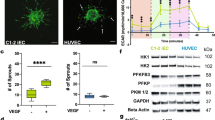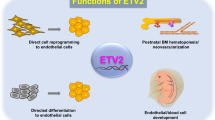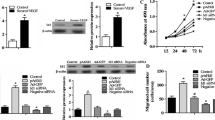Abstract
Egfl7 (VE-statin) is a secreted protein mostly specific to the endothelial lineage during development and in the adult and which expression is enhanced during angiogenesis. Egfl7 involvement in human postnatal vasculogenesis remains unresolved yet. Our aim was to assess Egfl7 expression in several angiogenic cell types originating from human bone marrow, peripheral blood, or cord blood. We found that only endothelial colony forming cells (ECFC), which are currently considered as the genuine endothelial precursor cells, expressed large amounts of Egfl7. In order to assess its potential roles in ECFC, Egfl7 was repressed in ECFC by RNA interference and ECFC angiogenic capacities were tested in vitro and in vivo. Cell proliferation, differentiation, and migration were significantly improved when Egfl7 was repressed in ECFC in vitro, whereas miR-126-3p levels remained unchanged. In vivo, repression of Egfl7 in ECFC significantly improved post-ischemic revascularization in a model of mouse hind-limb ischemia. In conclusion, ECFC are the sole postnatal angiogenic cells which express large amounts of Egfl7 and whose angiogenic properties are repressed by this factor. Thus, Egfl7 inhibition may be considered as a therapeutic option to improve ECFC-mediated postnatal vasculogenesis and to optimize in vitro ECFC expansion in order to develop an optimized cell therapy approach.




Similar content being viewed by others
References
Silvestre, J. S., Smadja, D. M., & Levy, B. I. (2013). Postischemic revascularization: from cellular and molecular mechanisms to clinical applications. Physiological Reviews, 93, 1743–1802.
Yoder, M. C., Mead, L. E., Prater, D., et al. (2007). Redefining endothelial progenitor cells via clonal analysis and hematopoietic stem/progenitor cell principals. Blood, 109, 1801–1809.
Melero-Martin, J. M., De Obaldia, M. E., Kang, S. Y., et al. (2008). Engineering robust and functional vascular networks in vivo with human adult and cord blood-derived progenitor cells. Circulation Research, 103, 194–202.
Soncin, F., Mattot, V., Lionneton, F., et al. (2003). VE-statin, an endothelial repressor of smooth muscle cell migration. The Embo Journal, 22, 5700–5711.
Parker, L. H., Schmidt, M., Jin, S. W., et al. (2004). The endothelial-cell-derived secreted factor Egfl7 regulates vascular tube formation. Nature, 428, 754–758.
Campagnolo, L., Leahy, A., Chitnis, S., et al. (2005). EGFL7 is a chemoattractant for endothelial cells and is up-regulated in angiogenesis and arterial injury. The American Journal of Pathology, 167, 275–284.
Schmidt, M. H., Bicker, F., Nikolic, I., et al. (2009). Epidermal growth factor-like domain 7 (EGFL7) modulates Notch signalling and affects neural stem cell renewal. Nature Cell Biology, 11, 873–880.
Lelievre, E., Hinek, A., Lupu, F., et al. (2008). VE-statin/egfl7 regulates vascular elastogenesis by interacting with lysyl oxidases. The EMBO Journal, 27, 1658–1670.
Poissonnier, L., Villain, G., Soncin, F., et al. (2014). Egfl7 is differentially expressed in arteries and veins during retinal vascular development. PLoS One, 9, e90455.
Bambino, K., Lacko, L. A., Hajjar, K. A., et al. (2014). Epidermal growth factor-like domain 7 is a marker of the endothelial lineage and active angiogenesis. Genesis, 52, 657–670.
Sun, Y., Bai, Y., Zhang, F., et al. (2010). miR-126 inhibits non-small cell lung cancer cells proliferation by targeting EGFL7. Biochemical and Biophysical Research Communications, 391, 1483–1489.
Wang, S., Aurora, A. B., Johnson, B. A., et al. (2008). The endothelial-specific microRNA miR-126 governs vascular integrity and angiogenesis. Developmental Cell, 15, 261–271.
Fish, J. E., Santoro, M. M., Morton, S. U., et al. (2008). miR-126 regulates angiogenic signaling and vascular integrity. Developmental Cell, 15, 272–284.
Hill, J. M., Zalos, G., Halcox, J. P., et al. (2003). Circulating endothelial progenitor cells, vascular function, and cardiovascular risk. The New England Journal of Medicine, 348, 593–600.
Smadja, D. M., Bieche, I., Susen, S., et al. (2009). Interleukin 8 is differently expressed and modulated by PAR-1 activation in early and late endothelial progenitor cells. Journal of Cellular and Molecular Medicine, 13, 2534–2546.
Smadja, D. M., Basire, A., Amelot, A., et al. (2008). Thrombin bound to a fibrin clot confers angiogenic and haemostatic properties on endothelial progenitor cells. Journal of Cellular and Molecular Medicine, 12, 975–986.
Battle, T., Arnal, J. F., Challah, M., et al. (1994). Selective isolation of rat aortic wall layers and their cell types in culture–application to converting enzyme activity measurement. Tissue and Cell, 26, 943–955.
Dupont, A., Corseaux, D., Dekeyzer, O., et al. (2005). The proteome and secretome of human arterial smooth muscle cells. Proteomics, 5, 585–596.
Reny, J. L., Laurendeau, I., Fontana, P., et al. (2004). The TF-603A/G gene promoter polymorphism and circulating monocyte tissue factor gene expression in healthy volunteers. Thrombosis and Haemostasis, 91, 248–254.
Pinte, S., Caetano, B., Le Bras, A., et al. (2016). Endothelial cell activation is regulated by epidermal growth factor-like domain 7 (Egfl7) during inflammation. The Journal of Biological Chemistry, 291, 24017–24028.
Smadja, D. M., Bieche, I., Helley, D., et al. (2007). Increased VEGFR2 expression during human late endothelial progenitor cells expansion enhances in vitro angiogenesis with up-regulation of integrin alpha(6). Journal of Cellular and Molecular Medicine, 11, 1149–1161.
Poissonnier, L., Villain, G., Soncin, F., et al. (2014). miR126-5p repression of ALCAM and SetD5 in endothelial cells regulates leucocyte adhesion and transmigration. Cardiovascular Research, 102, 436–447.
Foubert, P., Silvestre, J. S., Souttou, B., et al. (2007). PSGL-1-mediated activation of EphB4 increases the proangiogenic potential of endothelial progenitor cells. The Journal of Clinical Investigation, 117, 1527–1537.
Fitch, M. J., Campagnolo, L., Kuhnert, F., et al. (2004). Egfl7, a novel epidermal growth factor-domain gene expressed in endothelial cells. Developmental Dynamics, 230, 316–324.
Guerin, C. L., Loyer, X., Vilar, J., et al. (2015). Bone-marrow-derived very small embryonic-like stem cells in patients with critical leg ischaemia: evidence of vasculogenic potential. Thrombosis and Haemostasis, 113, 1084–1094.
Havens, A. M., Sun, H., Shiozawa, Y., et al. (2014). Human and murine very small embryonic-like cells represent multipotent tissue progenitors, in vitro and in vivo. Stem Cells and Development, 23, 689–701.
Kassmer, S. H., Jin, H., Zhang, P. X., et al. (2013). Very small embryonic-like stem cells from the murine bone marrow differentiate into epithelial cells of the lung. Stem Cells, 31, 2759–2766.
Kassmer, S. H., & Krause, D. S. (2013). Very small embryonic-like cells: biology and function of these potential endogenous pluripotent stem cells in adult tissues. Molecular Reproduction and Development, 80, 677–690.
Guerin, C. L., Rossi, E., Saubamea, B., et al. (2017). Human very small embryonic-like cells support vascular maturation and therapeutic revascularization induced by endothelial progenitor cells. Stem Cell Reviews, 13, 552–560.
Guiducci, S., Porta, F., Saccardi, R., et al. (2010). Autologous mesenchymal stem cells foster revascularization of ischemic limbs in systemic sclerosis: a case report. Annals of Internal Medicine, 153, 650–654.
Durrans, A., & Stuhlmann, H. (2010). A role for Egfl7 during endothelial organization in the embryoid body model system. Journal of Angiogenesis Research, 2, 4.
Smadja, D. M., Bieche, I., Silvestre, J. S., et al. (2008). Bone morphogenetic proteins 2 and 4 are selectively expressed by late outgrowth endothelial progenitor cells and promote neoangiogenesis. Arteriosclerosis, Thrombosis, and Vascular Biology, 28, 2137–2143.
Nichol, D., Shawber, C., Fitch, M. J., et al. (2010). Impaired angiogenesis and altered Notch signaling in mice overexpressing endothelial Egfl7. Blood, 116, 6133–6143.
Ingram, D. A., Mead, L. E., Tanaka, H., et al. (2004). Identification of a novel hierarchy of endothelial progenitor cells using human peripheral and umbilical cord blood. Blood, 104, 2752–2760.
Smadja, D. M., Bieche, I., Emmerich, J., et al. (2006). PAR-1 activation has different effects on the angiogenic activity of endothelial progenitor cells derived from human adult and cord blood. Journal of Thrombosis and Haemostasis, 4, 2729–2731.
He, T., Peterson, T. E., Holmuhamedov, E. L., et al. (2004). Human endothelial progenitor cells tolerate oxidative stress due to intrinsically high expression of manganese superoxide dismutase. Arteriosclerosis, Thrombosis, and Vascular Biology, 24, 2021–2027.
Urbich, C., Heeschen, C., Aicher, A., et al. (2005). Cathepsin L is required for endothelial progenitor cell-induced neovascularization. Natural Medicines, 11, 206–213.
Fan, C., Yang, L. Y., Wu, F., et al. (2013). The expression of Egfl7 in human normal tissues and epithelial tumors. The International Journal of Biological Markers, 28, 71–83.
Papaioannou, D., Shen, C., Nicolet, D., et al. (2017). Prognostic and biological significance of the proangiogenic factor EGFL7 in acute myeloid leukemia. Proceedings of the National Academy of Sciences of the United States of America, 114, E4641–E4647.
Huang, C. H., Li, X. J., Zhou, Y. Z., et al. (2010). Expression and clinical significance of EGFL7 in malignant glioma. Journal of Cancer Research and Clinical Oncology, 136, 1737–1743.
Delfortrie, S., Pinte, S., Mattot, V., et al. (2011). Egfl7 promotes tumor escape from immunity by repressing endothelial cell activation. Cancer Research, 71, 7176–7186.
Chim, S. M., Kuek, V., Chow, S. T., et al. (2015). EGFL7 is expressed in bone microenvironment and promotes angiogenesis via ERK, STAT3, and integrin signaling cascades. Journal of Cellular Physiology, 230, 82–94.
Shen, X., Han, Y., Xue, X., et al. (2016). Epidermal growth factor-like domain 7 promotes cell invasion and angiogenesis in pancreatic carcinoma. Biomedicine & Pharmacotherapy, 77, 167–175.
Charpentier, M. S., Tandon, P., Trincot, C. E., et al. (2015). A Distinct Mechanism of Vascular Lumen Formation in Xenopus Requires EGFL7. PLoS One, 10, e0116086.
Hu, M. H., Ma, C. Y., Wang, X. M., et al. (2016). MicroRNA-126 inhibits tumor proliferation and angiogenesis of hepatocellular carcinoma by down-regulating EGFL7 expression. Oncotarget, 7, 66922–66934.
Johnson, L., Huseni, M., Smyczek, T., et al. (2013). Anti-EGFL7 antibodies enhance stress-induced endothelial cell death and anti-VEGF efficacy. The Journal of Clinical Investigation, 123, 3997–4009.
Garcia-Carbonero, R., van Cutsem, E., Rivera, F., et al. (2017). Randomized phase II trial of parsatuzumab (Anti-EGFL7) or placebo in combination with FOLFOX and bevacizumab for first-line metastatic colorectal cancer. The Oncologist, 22, 375-e330.
Hansen, T. F., Christensen, R., Andersen, R. F., et al. (2013). MicroRNA-126 and epidermal growth factor-like domain 7-an angiogenic couple of importance in metastatic colorectal cancer. Results from the Nordic ACT trial. British Journal of Cancer, 109, 1243–1251.
Acknowledgements
We thank the animal Platform, CRP2 - UMS 3612 CNRS - US25 Inserm-IRD – Faculté de Pharmacie de Paris, Université Paris Descartes, Paris, France. We are indebted to the nursing services of Hôpital des Diaconesses (Paris) and Begin (Saint Mandé) for providing umbilical cord blood samples. This work was supported by grants from Région Ile de France-CORDDIM (Domaine d’intérêt majeur Cardiovasculaire Obésité Rein Diabète) and the Conny-Maeva Charitable Foundation. Elisa Rossi’s salary is supported by a grant from the Conny-Maeva Charitable Foundation.
Author information
Authors and Affiliations
Corresponding author
Ethics declarations
Conflict of Interest
Authors do not have any conflict of interest to declare.
Rights and permissions
About this article
Cite this article
d’Audigier, C., Susen, S., Blandinieres, A. et al. Egfl7 Represses the Vasculogenic Potential of Human Endothelial Progenitor Cells. Stem Cell Rev and Rep 14, 82–91 (2018). https://doi.org/10.1007/s12015-017-9775-8
Published:
Issue Date:
DOI: https://doi.org/10.1007/s12015-017-9775-8




